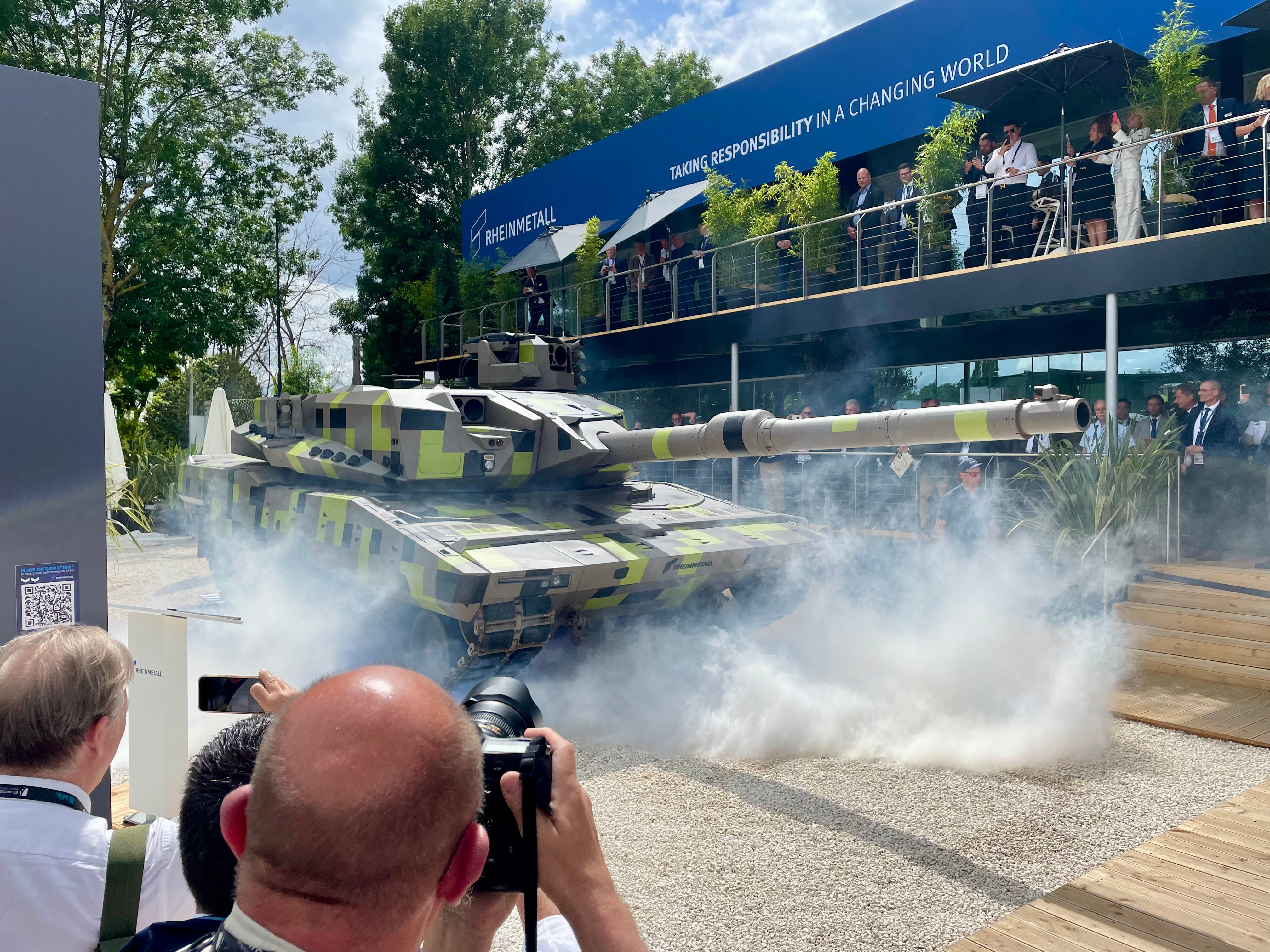PARIS — If Europeans fail to pull off a common next-generation battle tank design, it will not have been for a lack of ideas.
Industry frenemies KNDS and Rheinmetall each presented new concepts here touting major improvements to existing tank fleets, keenly aware that the fluid schedule of the Franco-German Main Ground Combat System could be decades away from fielding a weapon.
KNDS — the joint venture of Germany’s Krauss-Maffei Wegmann and France’s Nexter — unveiled the Leopard 2 A-RC 3.0 at a brief ceremony, where development head Axel Scheibel diplomatically spoke of the “slightly delayed” marquee program between Berlin and Paris. “We have to have a next-gen tank” before that, he told reporters.
Envisioned features include a weight savings of 10% over the 60-plus-ton Leopard 2. Engineers hope to achieve this through cascading modifications that include a new gun design, which enables the relocation of the three-person crew more deeply into the protected chassis, thereby saving on armor weight spent on protecting personnel located further up in the tank.
The linchpin of the idea is a main gun movable on two pivot points, causing the barrel to rest level above the chassis at all time, obviating the need to account for dead space from the cannon’s back swinging around, Scheibel explained.
The company envisions a choice of 120mm-, 130mm- or 140mm-caliber guns, incorporating a trend toward larger projectiles for longer range and heftier kinetic punch.
A new munition delivery system is also part of the concept, borrowing from soda bottle distributors the idea of cubed storage containers that can feed three initial rounds to the barrel within 10 seconds, Scheibel said.
With the gun and turret concept complete, KNDS plans to unveil a fully functioning demonstrator at the Eurosatory show in 2026, spending the time until then fleshing out the chassis design, Scheibel said. The company has already driven and fired the A-RC 3.0 tank in a testable configuration and presented the design to the German armed forces, the Bundeswehr, he added.
The collection of modifications can be applied to existing Leopard 2 tanks, which is where much of the market is expected to lie in the future, Scheibel told reporters. “It’s not tricky,” he said, because the two-pivot cannon design enables something of a clean-slate approach for tweaking the rest of the system.
Meanwhile, KNDS presented a development version of the French Leclerc tank fitted with a 120mm Ascalon gun, with a barrel that can be swapped out to fire 140mm munitions. KNDS France has already tested the system, with the barrel switch taking about 25 minutes, according to Francois Groshany, who runs tracked armor programs at the French arm of the company.

The Leclerc Evolution tank is proposed as a new build. And while existing Leclerc platforms could potentially be refitted, “that’s a question of economics,” Groshany told reporters during a walk around KNDS France’s offering Monday. The French tank is meant to complement the Leopard 2 offering rather than compete with it “to address markets for which the Leopard isn’t relevant.”
The company sees realistic possibilities to find buyers, “otherwise we wouldn’t launch it,” Groshany said, adding that there’s a market for hundreds of main battle tanks in the next 10 to 15 years.
The Ascalon cannon’s capabilities will be able to go “well beyond” those of the current generation of 120mm guns, with the company targeting an energy impact on the target of at least 10 megajoules. The Leclerc upgrade is proposed with a 22-round autoloader in a two-person turret, with a two-person chassis including the deputy commander. Armament would also include a 30mm gun for anti-drone purposes, plus a launcher for loitering munitions.
Rheinmetall, which managed to pull off a big splash at the Eurosatory 2022 iteration with the surprise introduction of its Panther KF51 tank, presented yet another model on Monday. An unmanned turret, the company said, will enable the crew to sit lower in the protected chassis and provide 25 “ready rounds” for the 130mm main gun.
Bjoern Bernhard, the company’s head of vehicle systems in Europe, introduced the development amid what he called the “obvious postponement” of the Franco-German Main Ground Combat System program. “We’ve seen that MGCS is not getting ahead as planned,” he said.
Charles Beaudouin, a retired major general and former head of the French Army’s equipment office who now runs Eurosatory as CEO of COGES Events, lauded the level of activity here surrounding tank technology.
“I myself am surprised,” he told Defense News. “In my opinion, as a former officer, the groundswell is much more important than we think. It’s not an adaptation, it’s a transformation of European armed forces.”
Sebastian Sprenger is associate editor for Europe at Defense News, reporting on the state of the defense market in the region, and on U.S.-Europe cooperation and multi-national investments in defense and global security. Previously he served as managing editor for Defense News. He is based in Cologne, Germany.
Rudy Ruitenberg is a Europe correspondent for Defense News. He started his career at Bloomberg News and has experience reporting on technology, commodity markets and politics.







